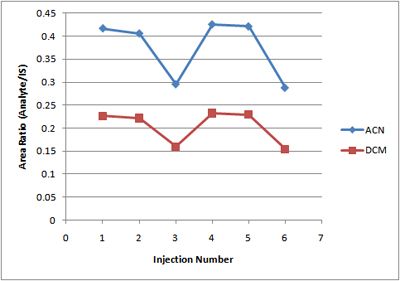-
- Posts: 6
- Joined: Mon Oct 31, 2011 11:51 pm
I am experiencing weirdness. One analyte of three in the same solution has large changes in area count, while the other two analytes do not.
GC: Varian 3900 running a DB-624 30m x .53mm x 3um column, 1ul injection
Temperature ramp from 40C to 200C over 35 minutes.
Injector port at 220C, detector 225C.
Split ratio 10:1. He / H2 / Air system
Solutions: ACN 79ug/mL, DCM 132 ug/mL, Ethyl nicotinate 111 ug/mL in DMSO. Ethyl nicotinate is functioning as the internal standard.
Area counts (individual vials, same prep)
Inj ACN DCM EtNic
1: 379 206 909
2: 375 205 924
3: 359 194 1213
4: 392 214 921
5: 395 215 938
6: 360 193 1249
(sorry about the collapse of the formatting there)
Is this non-homogeneity of the solution? An intermittent active site in the instrument? Funky autosampler activity?
Thanks for any insights ya'll may have.
Ned

